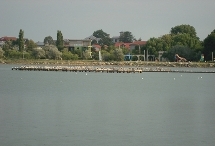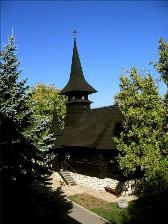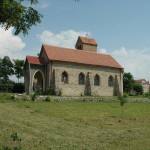Overview | History | Population |Location | Touristic Attractions | Tourism Infrastructure | Touristic Programs | Touristic Destinations | Associations | Accomodation
Techirghiol, known as spa resort since 1899, is bathed in sunshine and caressed by the saline air, partly coming from the sea, partly from the lake.
Lake Techirghiol, located on the Black Sea coast, between the towns of Techirghiol, Eforie Nord and Eforie Sud, is the largest salt lake in Romania, with 7,500 m length, maximum 9 m depth and a salinity of over 90 g/l. Lake Techirghiol is fundamentally different from the other lakes, as regards its physical and geographical aspects, even if it has a similar genesis (as fluviomarine liman). The average water temperature is generally close to the one of the air. Due to the high mineralization, the water temperature of Lake Techirghiol can drop below 0°C without freezing. The invertebrate fauna that populates Lake Techirghiol is dominated by the Artemia salina crustacean, which together with the Cladophora crystalina alga provides the basic material for the production of sapropelic mud with active mineral components, which accounts for its special therapeutic value. Lake Techirghiol is a very important avifaunistic area, declared Ramsar site in 2006 (with a surface of 1,462 ha). Techirghiol is the home of globally threatened bird species, among which the Red-breasted Goose (Branta ruficollis) and the White-headed Duck (Oxyura leucocephala). Besides the migratory bird species, it is remarkable also the high number of nesting species in this area.
the towns of Techirghiol, Eforie Nord and Eforie Sud, is the largest salt lake in Romania, with 7,500 m length, maximum 9 m depth and a salinity of over 90 g/l. Lake Techirghiol is fundamentally different from the other lakes, as regards its physical and geographical aspects, even if it has a similar genesis (as fluviomarine liman). The average water temperature is generally close to the one of the air. Due to the high mineralization, the water temperature of Lake Techirghiol can drop below 0°C without freezing. The invertebrate fauna that populates Lake Techirghiol is dominated by the Artemia salina crustacean, which together with the Cladophora crystalina alga provides the basic material for the production of sapropelic mud with active mineral components, which accounts for its special therapeutic value. Lake Techirghiol is a very important avifaunistic area, declared Ramsar site in 2006 (with a surface of 1,462 ha). Techirghiol is the home of globally threatened bird species, among which the Red-breasted Goose (Branta ruficollis) and the White-headed Duck (Oxyura leucocephala). Besides the migratory bird species, it is remarkable also the high number of nesting species in this area.
Techirghiol resort benefits also from special natural conditions, materialized in the presence of health promoting natural factors, such as: climate, sapropelic mud and the lake’s salt water. All these factors together form the treasure of Techirghiol resort.
The steppe continental climate, with marine influences, is determined by the geographical lay-out of the resort, only 3 km away from the Black Sea coast, in a Dobrogean steppe region. This type of climate determines a reduced thermal comfort, which implies an intense adaptative stress on the body, especially through its mechanisms of thermoregulation . Climatotherapy in Techirghiol resort is recommended both as preventive and curative therapy in multiple locomotive, gynecological, dermatological and other disorders, during May – September, associated also, as the case may be, with cold mud baths.
The sapropelic mud from the lake is a treasure of the resort, which brought fame to this place. Thus, in 1924, the Techirghiol mud received the gold medal at the Universal Exposition in Paris. The mud is sedimented on the bottom of the lake, in certain areas, on a total surface of about 98 ha, in a layer about 0.6 m deep.
The black mud has black oil color, is shinny, unctuous, with a characteristic smell and physical properties that make it very useful in the treatment of certain disorders; it is unique from all points of view. Thus, the mud is spreadable and can take the shape of the body (it is plastic); it absorbs water like a sponge, and can also mix very well with water (hydropexic); it stores heat easily (thermopexic) when heated, and transfers it slowly to the body (has a low thermal conductivity); this is why, when applied hot on the skin, the warmth sensation is lower than for a bath with water at the same temperature. The mud is a substance with complex chemical composition, formed as a result of an extremely long biological process (called peloidogenesis), in the specific environment of Lake Techirghiol. The mud contains organic and inorganic solid substances, shaped as granules with very small diameter, organic and mineral colloidal substances, and the water from the lake, where a lot of substances and gases are dissolved. The mud is used in heated form, for several spa procedures: mud packs, cataplasms, vaginal pads and mixed with salt water from the lake, for therapeutic tub baths. On the beach set up on the lake shore and located just in front of the Balneotherapy Center, the mud is still used, during the warm season, for inunctions. This is the first and most ancient mud treatment method. It has been useded as early as the 19th century for treatment, first on an empirical basis, then substantiated on a scientific basis. Also, the therapeutic use of mud was first studied by Alphons Saligny, then by the Romanian Balneology Institute; beginning with the 1930s, these studies represent a solid scientific base regarding the therapeutic action of mud, and the methodology for mud treatments.
The salt water of Lake Techirghiol is highly hypertonic, with a concentration of ca 80 g mineral salts per liter. Lake Techirghiol is a former maritime gulf, isolated from the sea by a sand stripe. Over time, this lead to a strong concentration of salts from seawater, considering the dry climate of the region. The total mineralization of the lake water is 52 g/l. Being so concentrated, the water can be used as such only in external cures, for cold and hot baths, in basin or in bathtub. The water holds its therapeutic effect through its temperature, its chemical composition and its high density. All these determine an Archimedes force higher than plain water, thus giving an increased feeling of lightness of the limb or body submerged in it.
Besides the special natural conditions, Techirghiol resort benefits from the existence of one of Romania’s most modern physiotherapy spa, located in the Balnear and Rehabilitation Sanatorium of Techirghiol . The spa provides balneo-physical treatment for inpatients, in the three sections of the sanatorium, and also outpatient treatments.
The Balnear and Rehabilitation Sanatorium of Techirghiol is built on two floors, can treat up to 800 patients daily, and can provide over 2,500 spa procedures, in a wide range of therapeutic and spa treatments (procedures).
Very close to the Balnear and Rehabilitation Sanatorium of Techirghiol is located the Saint Mary Monastery, an oasis of peace and spiritual relaxation. Merciful sisters, with a lot of love for God and for people, are welcoming us on porches loaded with geraniums and roses. The small wood church was first built in the heart of Maramureș country, and then it was moved to the Stâna Regală (Royal Sheepfold Glade), in Sinaia. When he was a child, His Majesty King Michael of Romania used to pray in this church. The church was transferred to Techirghiol in 1951. Inside the monastery, the tourists can visit a small, but very important museum that displays proofs of Christianity in Dobrogea. Since 2000, the Saint Mary Monastery accommodates a modern spa facility, where several spa procedures can be applied, upon recommendation of the medical specialist: galvanization, ionogalvanization, diadynamic currents, interferential currents, ultrasounds, functional electrical stimulation, galvanic baths, mud baths, mineral baths with water from Lake Techirghiol, plant baths, massage, kinetotherapy, ergonomic bicycle, laser-therapy, sauna. The tourists who wish to benefit from these services can stay in the monastery´s own accomodation facilities, classified as a **hotel, with 70 rooms with private bathroom, TV and refrigerator.
close to the Balnear and Rehabilitation Sanatorium of Techirghiol is located the Saint Mary Monastery, an oasis of peace and spiritual relaxation. Merciful sisters, with a lot of love for God and for people, are welcoming us on porches loaded with geraniums and roses. The small wood church was first built in the heart of Maramureș country, and then it was moved to the Stâna Regală (Royal Sheepfold Glade), in Sinaia. When he was a child, His Majesty King Michael of Romania used to pray in this church. The church was transferred to Techirghiol in 1951. Inside the monastery, the tourists can visit a small, but very important museum that displays proofs of Christianity in Dobrogea. Since 2000, the Saint Mary Monastery accommodates a modern spa facility, where several spa procedures can be applied, upon recommendation of the medical specialist: galvanization, ionogalvanization, diadynamic currents, interferential currents, ultrasounds, functional electrical stimulation, galvanic baths, mud baths, mineral baths with water from Lake Techirghiol, plant baths, massage, kinetotherapy, ergonomic bicycle, laser-therapy, sauna. The tourists who wish to benefit from these services can stay in the monastery´s own accomodation facilities, classified as a **hotel, with 70 rooms with private bathroom, TV and refrigerator.
Another touri stical attraction is the German Church. Father Pieger, who is the leader of the German community, formed by Dobrogean German ethnics, contributed to the building of the church that was finished in 1934.
stical attraction is the German Church. Father Pieger, who is the leader of the German community, formed by Dobrogean German ethnics, contributed to the building of the church that was finished in 1934.
More than 100 years passed since the cornerstone of the holy church Sfântul Prooroc Ilie Tesviteanul (Saint Prophet Elijah) was laid in Techirghiol.